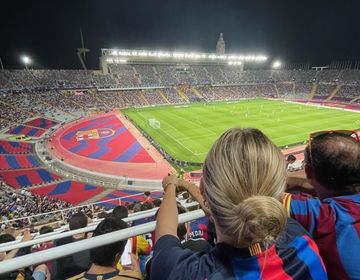Barcelona cultural shock advice
By: Masani Salazar
Going abroad to Spain is my first time outside of the United States. I have encountered many new cultural shocks so I wanted to compile the most shocking ones for me into this blog. I hope that these forewarning observations help other study-abroad students on how to overcome these situations. So when it happens it is not anything new just something to look out for. Most of them aren't too serious they are just minor habits that you have to slightly change for a temporary amount of time.
THE DINING & SERVICES
When going out to eat in Barcelona, Spain it is very common to go enjoy a coffee or a tapa. From my observations in Spanish cafes and restaurants, I have observed how there is a new way of how this business is done. The experience you receive is different in the sense that the waiting staff is more patient when you are deciding on your order and are as hospitable and attentive. Whereas in the U.S. there is an unspoken cultural norm in the restaurant business where their goal is to make the experience as quick and convenient as possible. But, here ordering anything is treated as a leisurely experience where you enjoy the present moment probably because lunch is the longest and most filling meal of the day. I was used to automatically paying after ordering anything in the U.S. but here it is not a rule. It is customary to enjoy the ambiance by sitting down and waiting. Here there is not a sense of a rush until I'm ready to leave I ask for the bill or go up to the cashier. From my past experience of dining in America, you feel like the staff is subconsciously trying to push you out kindly for the next customer. At first, I felt this cultural difference was unusual and backward from what I was used to. Have accepted the fact that Spain restaurant service wants you to receive the product and experience it before you even think of paying. After being here for more than 2 months I sometimes still forget that they do the payment part in a different part of the process. Have learned to be more patient and present when eating or drinking at cafes or restaurants.
On a side note another piece of advice being abroad relating to the dining services is about the placement of the bathrooms. This may be seen as a silly observation but as an architecture student understanding the programming of buildings, is always in the back of my mind. Believe it or not, I was confused about where the bathrooms were located, because of their usual location in the back of the main floor at least in America. After asking staff in multiple different locations where to go, if it wasn't in the back of the entrance floor. I was repeatedly told it was downstairs, this location was unfamiliar. Now I know where to look before I ask to go either up or down a floor. I hope that this advice will help someone else not have to ask as many times as I did at first. Also took it as a teaching moment of how Spain has a preference of where they place the bathroom for architecture programming purposes. In my opinion, I thought about the sanitary purposes in my mind, and it does make more sense to place it away from the kitchen or other dining tables.
THE MEAL & TIME SCHEDULE
Next, is adjusting to the unaccustomed meal and store time schedule which relates back to the siesta culture they practice. Siesta in English means to nap so stores and restaurants take a break during the times of 2-5 in the middle of the day. It is more common for places outside of Barcelona to practice it more strictly. So don't worry in Barcelona you can still find places open since it is such a busy international city. But I've noticed there is still a decline of stores and restaurants closed during that time. Mostly depends on what time you go out trying to buy whatever specific product determines what options you'll have. At least for me, I am a night owl and this change benefited me because I usually start my day later. If you are an early riser you will see on the street that there is less of a store and restaurant selection to choose from. Not until later everything starts for business which is around 5 in the evening. Also, the amount of people in the street starts to rise as well. Another cultural difference is my dinner meal time in Spanish culture it is normal to eat at 9. In my situation being in a homestay made me adapt to eating at 9 every night with my Catalonian host mom. Eventually made even more sense after starting my school schedule especially since my classes barely finish by around 7-8. The upside to this new schedule is how many places such as bars, restaurants, and recreational spaces are running as if it were the daytime in America.
WHAT ABOUT THE LANGUAGE BARRIER?
Now you may be thinking that the only language they speak is Spanish but to your surprise, Barcelona is a providence inside of the Catalonian Region of Spain. At first, I was under the impression most of the metro or store signs would be in Spanish. Instead, most of it is in Catalan, then Spanish/Castellano, and ends with English. A way to tell a Catalan word is if it has a “t” at the end or if there is a “u” in the word and may sound a tad, French. One store you can not miss that uses Catalan in their signage is Supermercats. I also find it fascinating that this language is a mix of mostly Spanish & French maybe a little bit of Italian too! Before I came I made sure to practice my basic Spanish skills through apps like Duolingo or used other resources to practice my Spanish with, such as some of my family members or my Mexican friends. But being here has taught me you can still communicate no matter where you are. If you really need to communicate in English there is most times or not someone who can help you. Everyone here is at least fluent in 2-5 languages with English being the most spoken. If you are trying to use some Spanish phrases when ordering it is often acceptable to mess up or not have the best accent. Either way, the waiter will either understand what you trying to say and play along with it by responding in Spanish or automatically respond in English. At least for me, I have had many background examples being around Spanish hearing the accent, and knowing when to enunciate certain vowels. So in the beginning when I got a little more confident ordering a whole meal in Spanish, my accent helped immensely even though there was some simple vocabulary I didn't know. If that happens I use the tone of the voice or contextual keyword in the sentence to infer what they are talking about. Usually, my accent would trick the native spanish speakers making them think I knew more than I did which benefits me in most situations. Even if your goal wasn't to learn Spanish here it would still be smart to practice some basic pronunciation or phrases for yourself. If you can't get through with your Spanish, English is always the best backup because it is so international everywhere.
PUBLIC DISPLAYS OF AFFECTION IN PUBLIC
Another Spanish norm I've noticed is the increased amounts of public displays of affection I see. At first, it was unusual and shocking to me because of how Americans usually view that stitch. But is not unusual to see couples or even friends kissing and hugging each other. It is acceptable to have more physical contact and affection here. For example, when I first met my host mom she gave me quick kisses on the left and right side of my cheeks. I knew this fact before coming to Spain but it still took me by surprise when it happened. Also since my homestay is located in the Champla neighborhood where there are a ton of bars and clubs it is very common to see people in the park, club, street, and restaurant kissing. I do what anyone else does mind their own business and walk on not bothering them. A valid reason why there are so many young couples or anyone being affectionate is because people live with their parents longer. This results in people finding other places to kiss or hug without doing it in their parents' homes. Maybe if you get comfortable enough you will start picking up the kisses on the cheeks with others.
Experiencing Spain for the first time has been a whirlwind of cultural differences, for me, a first-time traveler outside the United States. From intriguing cafe and restaurant businesses to late mealtimes, a different siesta culture, and new PDA social norms. Every new encounter has been a learning and unforgettable experience that is only a minor adjustment from my American norm. I have compiled these to help other study-abroad students prepare. These differences might seem big at first, but they’re temporary changes waiting to be embraced for when you come.
Related Posts
11 Tips I Wish I Knew Before Studying Abroad
By: Alexa Levy Hi all! My name is Alexa Levy. I studied abroad through CIEE in Barcelona during my junior year of college, doing the Global Architecture and Design Program... keep reading
Architecture Student Abroad
By: Valeria Cedeno Studying architecture abroad is something I'll never forget, and it shaped me in ways I never expected. As an architecture student, I had this amazing opportunity to... keep reading
How to Cope with Culture Shock and Homesickness
By: Alexa Levy Studying abroad can be a daunting—frankly, even terrifying—adventure. Leaving behind what’s familiar to embrace the unknown is a lot easier said than done. My first study abroad... keep reading






